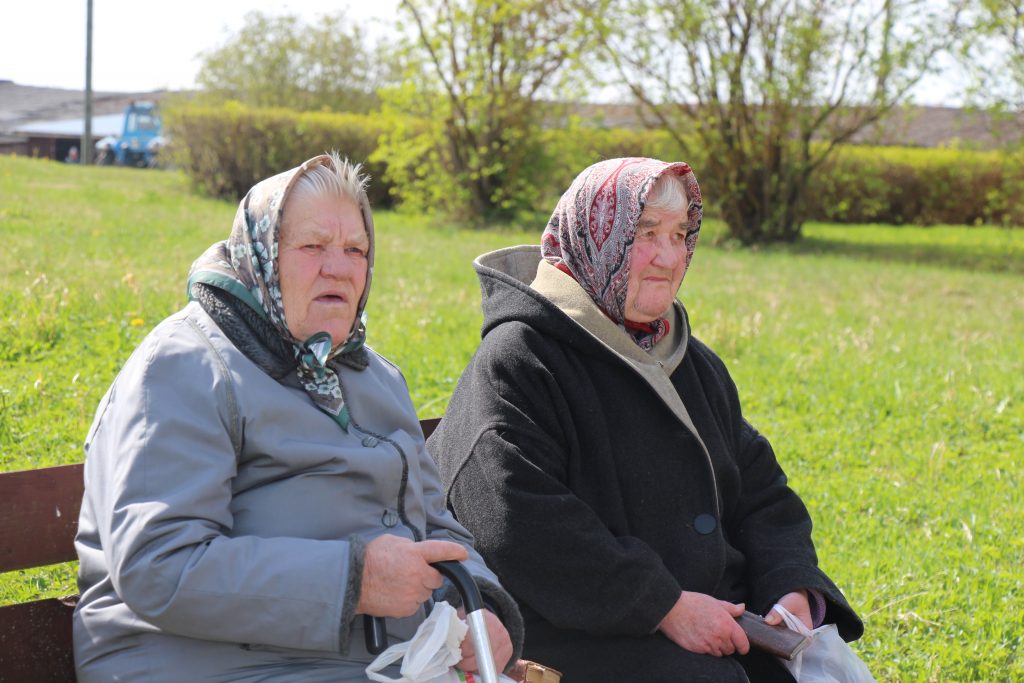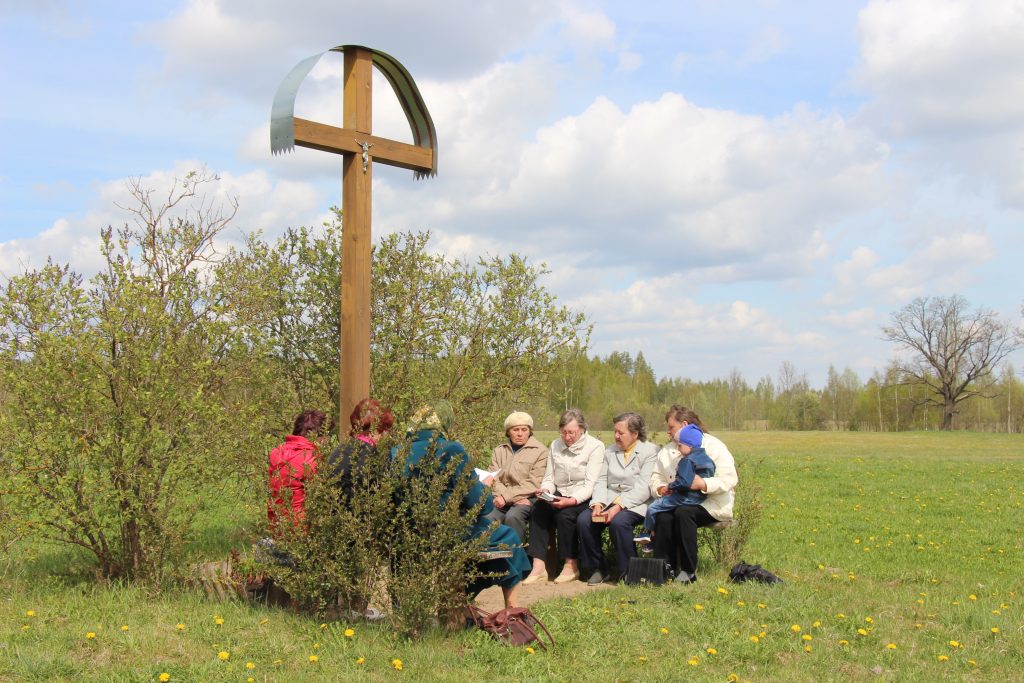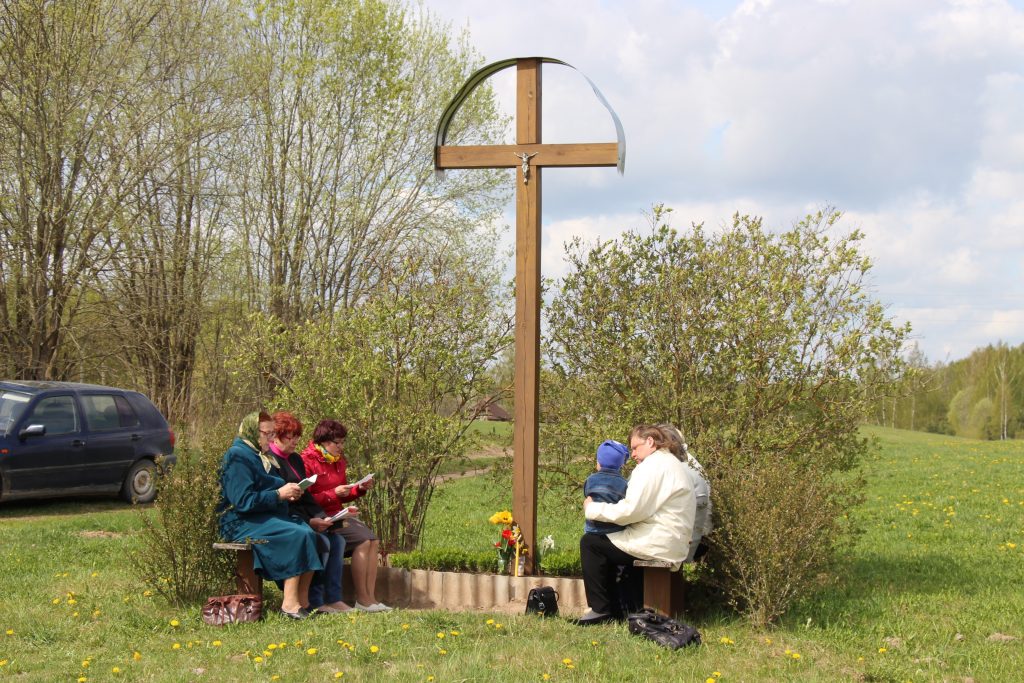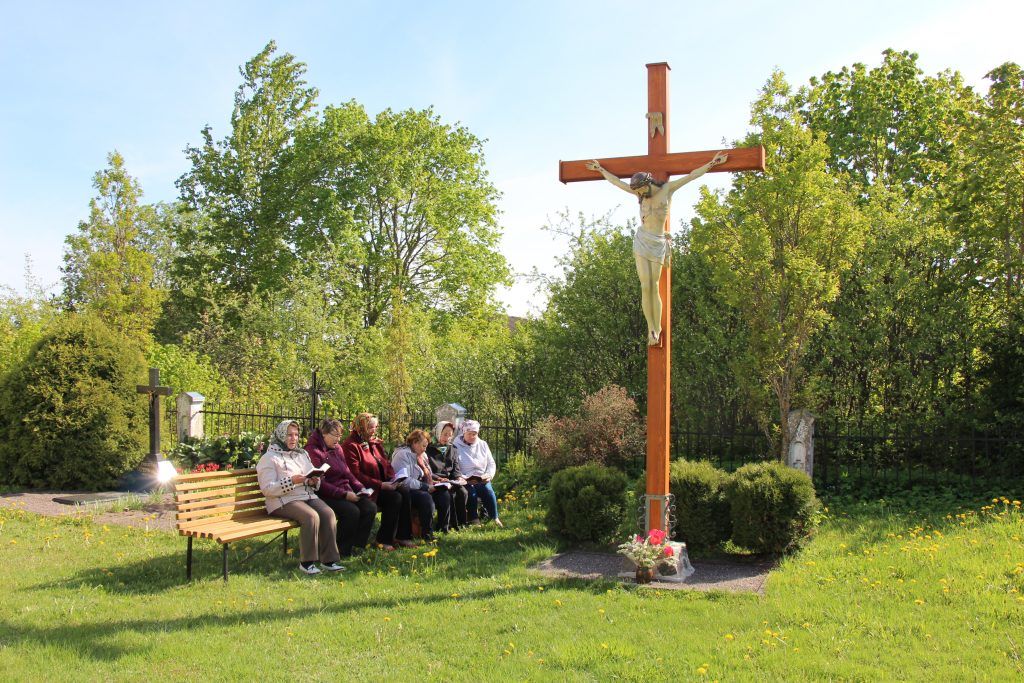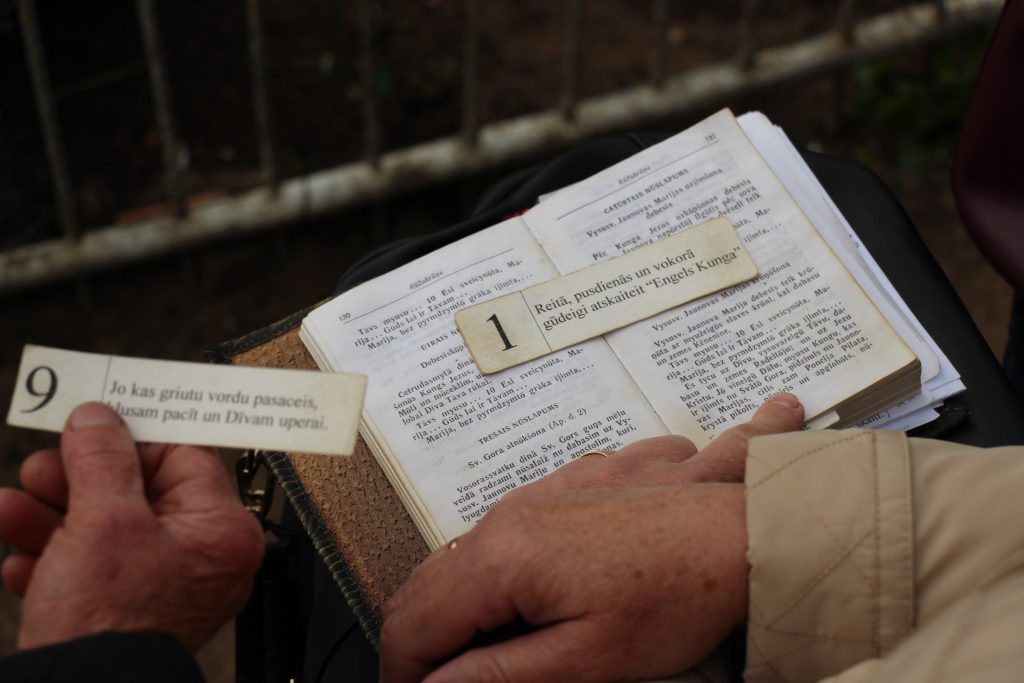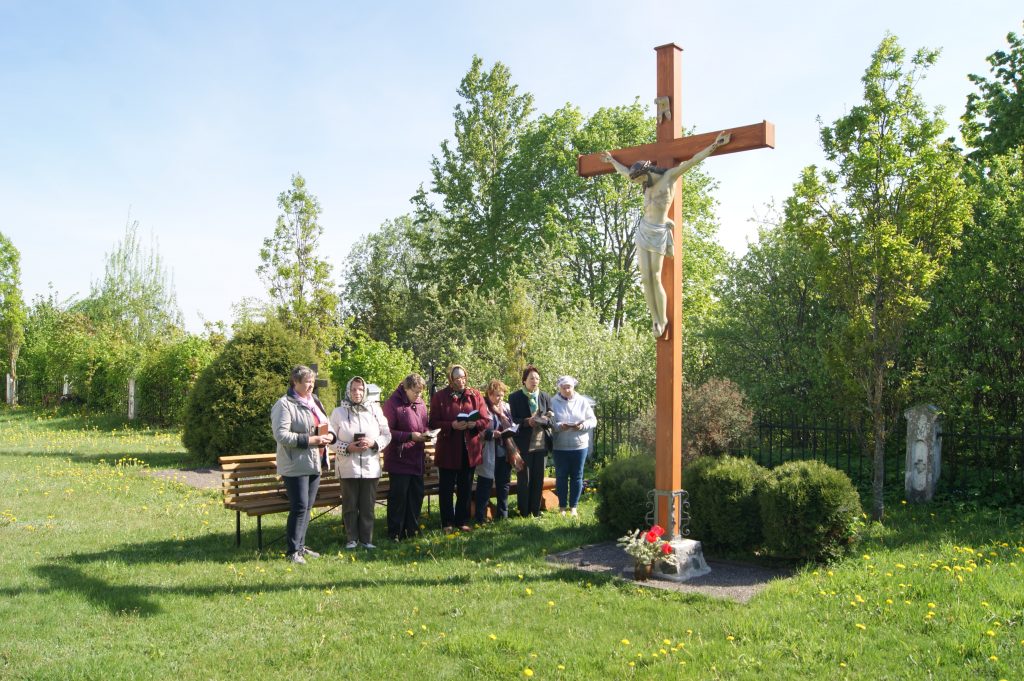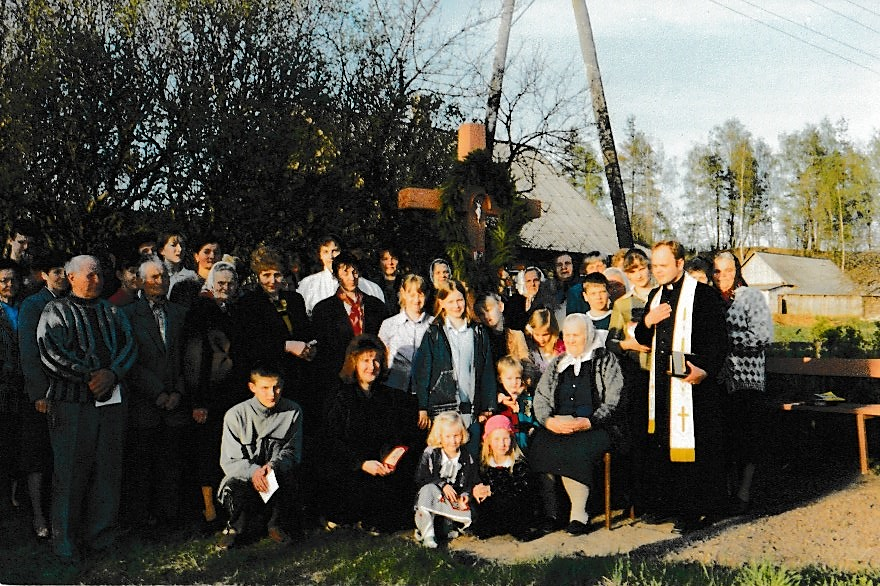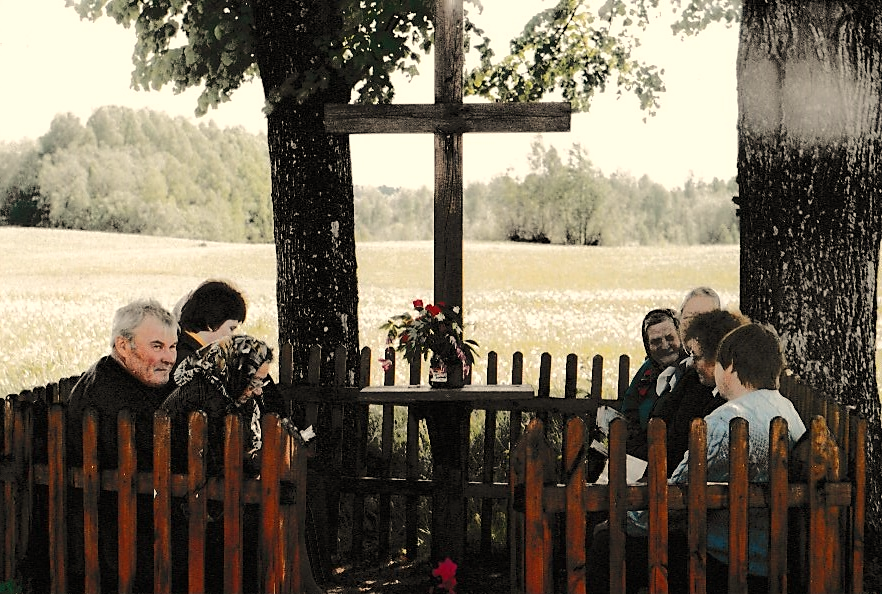Author:
Inta Vilnius
Social practices, rituals and festive events
Title
May services at roadside crosses in Andrupene and Šķaune Parishes (2019)
Dzidošana pi krysta, Maja dzidojumi
The May Services at roadside crosses is a ritual (service). The ritual environment is associated with roadside crosses as an integral part of the service; the drawing of “značkas” is unique.
Geography
Andrupenes civil parish and Šķaune civil parish.
The Element is associated with communities within certain parishes of the Krāslava Municipality – these are places where roadside crosses have been erected. These are open communities in the sense that the number of singers varies from time to time in terms of the number of people involved in the practice, i.e., singing at the cross in May.
It is also possible for others to join spontaneously. It is the active keepers of the tradition who take care of the area around the crosses, decorate them, gather for the services in May, and consider the tradition to be of great value.
In the parish of Šķaune this community partly coincides with the folklore group Gaiļupeite and in Andrupene with the church choir. In the village of Astašova, the community consists of local residents who, with their own funds, buy everything needed to tidy up and beautify the area around the cross (a new flower bed at the foot of the cross, which not only pleases the eye but also attracts the attention of passersby, candles are lit during the service, young birch trees are brought to the cross at Pentecost).
In parishes where May services are no longer held at roadside crosses, some individuals still maintain the area around the cross, decorate the cross itself (especially in May), and come to recite a prayer alone.
The parish councils are responsible for cleaning the crosses and replacing the old ones with new ones.
Significance in community life
In the Viļaka Municipality, roadside crosses, like any sacred place, are treated with special respect. Elderly people passing by a roadside cross stop, cross themselves, linger for a moment, and only then move on.
The area around the crosses is always tidy and the crosses themselves, especially in May, are beautifully decorated, whether or not there is a service at the cross. The crosses are maintained by the villagers or by the landowner who lives near the cross. Fresh flowers are placed at the foot of the cross during the warm season but are replaced by artificial decorations when the weather turns cold. This Element is especially important in places far from the church. There, the roadside cross serves as a kind of small church for the locals.
Activities
People gather at the crosses as early as April 30th. The service on that day is distinctive in that two types of “značkas” (a numbered rectangular piece of paper that indicates the task to be completed by the marker within a certain time frame) are drawn: those that are to be completed during the entire month of May, and one-day “značkas” indicating tasks that are to be completed by the following day. The faithful fulfill the "značkas" biddings with great seriousness, trying to overcome at least one of their weaknesses and to strengthen their virtues and willpower.
The May service is always led, directly or indirectly, by one or two leaders. These are the people who have the most intimate knowledge and control of the entire service. Usually, it is an experienced singer who decides which songs to sing, leads the singing, or directs people to sing.
Beliefs, rituals, and unwritten rules
The May Service is a strictly structured and complex system. It can be divided into five elements – the songs dedicated to Virgin Mary, the Litany of the Blessed Virgin Mary, drawing of the “značkas”, as well as readings and prayers. There are many variations of songs dedicated to Virgin Mary, that is, the singers choose what to sing at each particular time because there are quite a lot of such songs. These songs are mostly performed in a two-part harmony without special training.
Passing on and transferring skills
Today, the worship service is mainly attended by women, and there is a lack of younger generation participation.
Most of the singers have inherited the tradition of May worship from their childhood. They have gone to the cross to sing with their families, peers, and neighbors. Since singing at the Cross was an important part of their childhood for most of the participants in the May services, it seems natural that they would want to keep this tradition alive.
In the Muižnieki village of Šķaune parish, the age of the participants in the May service ranges from 46 to 90 years. Three of the seven participants have inherited the May worship tradition since childhood, while the others have joined later and thus participate in maintaining the ancient tradition.
In the village of Zamšoviki, Šķaune parish, the age of the participants in the May celebration ranges from 43 to 80 years. Gertrūde Reča says that she is the only one among the ten or so participants who gather at the cross who has done this as a child when she went to the roadside cross in her native village with her grandmother, so she is the one who leads the service and starts the songs.
In the village of Astašova, in the parish of Andrupene, the age of the participants in the May services ranges from 38 to 75 years. The oldest participant, Zinaīda Ostrovska, has participated in the May services at the roadside cross in her native village, which is next to Astašova, since her childhood and youth.
Every day from April 30 until the end of May, 4-6 participants gather at the cross in Astašova and learn from Zinaīda the most complete recorded service at the cross, where the tradition of drawing the “značkas” is still observed, Bible readings, which are different for each day, take place, and the first gathering is on April 30. In the parish of Andrupene, the age of the participants in the May services ranges from 59 to 78 years. Three out of ten of the women who attend the service say that they have been honoring the tradition since childhood, and they hold services not only at the central cross, but also at other roadside crosses in Andrupene (at the cross at the Andrupenes Farmstead Museum and the cross on the road behind the Andrupene cemetery) to attract more participants and draw attention to the tradition.
History
A typical part of the Catholic landscape of Latgale are the roadside crosses, which once existed in almost every settlement. On the evenings of the month of May, people used to gather at the crosses, and thus one of the phenomena of Catholic culture in Latgale developed – communal prayers to the Virgin Mary or singing at the cross.
The Latgalian Catholic folk prayers at the crosses, popularly called “dzīduošona pi krysta”, “maja dzīduojumi”, were essentially a peculiar form of folk liturgy, as they were held on their own initiative – without the presence and leadership of the clergy.
The leaders of the May services at the roadside crosses were the people themselves, mostly older women who knew the structure of the ritual well and knew how to start the melodies at the right pitch.
In the second half of the 19th century and in the 1920s and 1930s this ancient and beautiful form of folk prayer was common and widespread among Catholics in the whole Latgale region. In the evenings of May, the villagers gathered around the cross and sang songs and recited prayers in honor of the Blessed Virgin Mary until sunset. It was not unusual for a traveler in the countryside to hear singing in several places at the same time.
May is the month of the Blessed Virgin Mary in the Roman Catholic calendar – a time when special services and prayers are dedicated to her.
The May services at the roadside (village) crosses are rituals of veneration of the Virgin Mary. They focus on songs in honor of the Blessed Virgin Mary. The melodies sung at the crosses were learned mainly in the family during the long winter evenings, so that the singers at the May services knew the melodies by heart. The lyrics were taken from prayer books. The selection and order of the songs were determined by the experience of the singers present and by local traditions.
The litany of the Virgin Mary (the Loreto litany from the 13th century) and the drawing of the “značkas” were also obligatory parts of the service.
The word “značka” is of Polish origin. A “značka” is a numbered rectangular piece of paper. The number on it indicates the task that the person who has drawn it has to complete within a certain time frame, e.g. “Nasaverīs par vysu dīnu uz tū pusi, kur cīši gribīs vērtīs (Don't look all day in the direction where you really want to look)” or “Par vysu mēnsei sorgojīs malōšonas un jo gadeisīs samalōt, tod tyuleit atskait vīnu reizi Tāvs myusu (Throughout the month, beware of lying, and if you happen to lie, immediately recite the Lord’s Prayer once).
When it is time to draw the “značkas”, the participants take turns in doing so (the leader of the rite keeps the notes in her prayer book).
Bible readings are an essential part of the service. They are different for each day in May. For each day of the month, from the first to the thirty-first, there are concrete and psychologically effective examples and advice on what to do and how to become more virtuous. For example, in the text for the first day of May, there is an implicit reference to the moral importance of caring for the crucifixes and the image of Mary. The aesthetic function here merges with the spiritual one: decorating the image of Mary is a gift to her.
During the Soviet era, countless crosses were destroyed, and the tradition of May devotions was suppressed. It survived only in a handful of remote places. After the Soviet era, the tradition experienced a strong revival, leaving behind stories of how tractors were used to destroy roadside crosses in Soviet times, and the sad fate of the tractor drivers who agreed to do so.
People also sing and pray at home, but these are not May services at the cross in the sense hitherto used. May services are also held in the church, along with the local folk tradition. The differences are quite remarkable: the May services at roadside or village crosses were held by the people themselves – without the presence of a priest; the church May services lack the essential elements of traditional services, such as the drawing of “značkas”, the readings and, of course, the setting. These are two completely different May celebrations: the first is an expression of popular tradition and traditional culture, and the second, which takes place in a church, is part of the liturgy of the church.
Nowadays, the tradition of May services at roadside crosses is experiencing a strong revival in the Krāslava Municipality. This is evidenced by the implementation of the Asūne communal project “Restoration of the Crucifix and Landscaping of the Asūne Churchyard”, the production and installation of a crucifix on the territory of the Andrupene Farmstead Museum, despite the fact that the project submitted to the State Cultural Capital Foundation was not supported, and the replacement of the old Andrupene central cross with a new one in 2018.
The initiative of the Šķaune folklore group Gaiļupeite, which was founded in 2013, to gather people for the May services at the roadside crosses in the Šķaune, thus continuing this tradition, also deserves mention.
Masters
The core of each community is made up of elderly women who have participated in May Services at roadside crosses with their parents and grandparents since early childhood.
Juzefa Ručevska (born 1929) takes care of the surrounding area of the Muižnieki village roadside cross, and, together with two more elderly women, Olga Rutka (also singing at funerals) and Stanislava Līce, lead the Service and start songs.
All three of them are the oldest of the Muižnieki roadside cross service attendees and are known to tell stories of how they used to go to roadside crosses in their early childhood. There used to be 11 of them, but now there are only 3.
Gertrūde Reča (born 1938) from the Zamšoviki village, Šķaune parish, is the oldest member, she leads the service, starts songs.
Gertrūde recalls that when she was a child, she went to a roadside cross near her home together with her grandmother.
Zinaīda Ostrovska (born 1943), from Astašova in the Andrupene parish, is the most senior member, conducting services, starting songs, organizing the “značkas” drawing, reading from the Bible, conducting singing (also at funerals).
In her childhood and youth, Zinaīda used to attend roadside cross services in her native Bikova village (the cross still stands, but the services no longer take place).
In Astašova, Andrupene parish, the most complete May Service at a roadside cross was registered – there is still a tradition of “značkas” drawing, reading the Bible, each day a different excerpt, and the first gathering takes place on April 30. The course of this day's service differs with the fact that two types of “značkas” are drawn, those you need to follow the entire month of May, and those you only need to follow for a day.
Antoņina Virza (born 1955) from Andrupene village, Andrupene parish, is the elder of the Andrupene congregation, she takes care of the area around the cross, coordinates the gathering of community members at the cross, leads the church service, and starts songs (together with Irīna Liepa).
Almost all the members of the Andrupene May Services also sing at funerals and have visited wayside crosses since they were children.
Agencies and institutions
Dagda Folklore Center – studies the development of the tradition of May services at roadside crosses in the Dagda area, providing necessary information to all interested people. In the future it is planned to attract the most important masters of the tradition for workshops, exchange notes, focus on developing and passing on the tradition.
Šķaune folklore group Gaiļupeite – maintains the crosses in their parish, organizes meetings in May at the crosses, is active in maintaining the tradition of May services.
In the village of Astašova, Andrupene parish, the community is made up of local residents who, with their own funds, buy everything they need to clean and beautify the area around the cross (a new flower bed was planted at the foot of the cross, which not only pleases the eye but also draws the attention of passersby to the place, candles are lit during services, young birch trees are brought to the cross at Pentecost).
All the local governments in the Dagda area take care of the crosses along the roads, replace the old ones with new ones, and provide financial support.
Consolidation
In 2004, the May worship at wayside crosses in the Dagda region was surveyed by Inta Viļuma, director of the Dagda Folklore Center. Several wayside crosses in Dagda and its surroundings were identified (to get a broader picture of the structure of the May services), video and photo recordings of the services were made. The materials are kept in the archives of the Dagda Folklore Center.
In 2019, the Element “May Services at Roadside Crosses in the Andrupene and Šķaune Parishes” was included in the Intangible Cultural Heritage Inventory of Latvia.
The project of the Catholic parish of Asūne “Restoration of the Crucifix and Landscaping of the Asūne Churchyard” was supported in the project competition “Society with a Soul 2019” of the Dagda Municipality (now: Krāslava Municipality) and the necessary funds were granted. The restoration of the crucifix was carried out by the local woodworker Staņislavs Maļķevičs.
On May 4, 2022, a new roadside cross was installed and consecrated in Muižnieki, Šķaune parish.
In the Dagda region, crosses are treated with special respect, as is any sacred place. The area around the crosses is always tidy, and the crosses themselves are beautifully decorated, especially in May. The crosses are cleaned by the local community, by the inhabitants of the village or by the landowner who lives near the cross.
The survey of the tradition of May services showed that in the Šķaune parish they are held every day during the whole month of May. Arita Rimša, a member of the Šķaune folklore group Gaiļupeite, is responsible for the event. 6–8 participants take part in the services. Additional information: https://www.facebook.com/photo/?fbid=770480571882133&set=pcb.770480828548774
In Astašova, Andrupene parish, a beautiful flower bed was created at the foot of a roadside cross on the initiative of the local community. In May 2024, Andrupene parish, in cooperation with the Dagda Cultural Center, painted the cross, the bench, and the fence.
The survey of the May worship tradition showed that services are held every day starting April 30. The person in charge of the celebrations is a local resident, Zinaīda Ostrovska. The services are attended by 6–7 participants. Additional information: https://www.facebook.com/photo/?fbid=770480678548789&set=pcb.770480828548774
On September 22, 2022, a lecture “May Day services at Roadside Crosses – a unique Latgalian Tradition” was held at the Central Library of Krāslava.
In 2024, a three-day Pentecost celebration was organized in Dagda and the surrounding parishes. On May 17 – the first day of the festival – free transportation was provided for all those who wanted to attend the May services in the parishes of Andrupene and Šķaune.
The tradition of May services at roadside crosses is met with growing interest. The crosses themselves and their surroundings have been tidied up.
Much contribution is made by local communities and parish administrations.
There are plans to participate in a project of the State Culture Capital Foundation to invite the most important masters of tradition to workshops.
Continuation/development
Measures planned for documentation and research of the Element:
• Identify and document the May worship tradition every 5 years. Responsible: Dagda Folklore Center; funding: State Culture Capital Foundation, local government budget;
• Once every five years, make a video recording at least one roadside cross in each Dagda community where this tradition still exists. Organize and archive the recordings. Storage at the Dagda Folklore Center. Responsible: Dagda Folklore Center, Dagda Culture Center; Funding: State Culture Capital Foundation, local government budget;
• Annual cleaning of the area around the roadside crosses. Responsible: Krāslava Municipality, local communities; financing: local government budget, community resources;
• Workshops at the Dagda Cultural Center in April (before the roadside services in May). Invite local storytellers to the workshops to share their know-how, develop and pass on the tradition, with special attention to the younger generation. Responsible: Dagda Folklore Center, Dagda Youth Initiative Center; Funding: State Culture Capital Foundations, local government budget;
• Include the tradition of the May worship services in the tourist guides of Dagda Municipality. Responsible: Dagda Tourism Information Center; Funding: TIC budget.
The objectives of the above activities are to promote, publicize, and develop the tradition.
Threats
There is a sharp decrease in the population, especially in rural areas, where the villages empty out one by one.
Applicant
Municipality of Krāslava Dagda town and parish association, Reg. No. 50900036651
Image Gallery
Audio Materials
Video
Publications
Pantele, G. (2002). The tradition of the May Service in Eastern Latvia. Book: Materials on Culture in Latvia. Riga: Zinātne, 200-214 p.
Miller, Semple (2000) – Eliot Miller, Kenneth R. Semple. The Cult of the Virgin: Catholic Mariology and the Apparitions of Mary. Riga: Lutheran Heritage Fund
Austra Sondore, A. (2010) Maija dziedājumi pie sādžas krusta Preiļu rajona Mozuļos. Personal archive of the author, Case 21
Šuplinska, I. (2012). Linguoterritorial Dictionary of Latgale. Rēzekne: Rēzekne Academy
Websites
https://kulturaskanons.lv/archive/maija-dievkalpojumi/ - Description of the tradition
http://www.katedrale.lv/index.php?id=3439 - Historical aspect of the tradition
http://www.ddmd.lv/index.php/lv/news-2/414-maijs-jaunavas-marijas-godinasanas-laiks - The origin and nature of the May Service
file:///C:/Users/INTA/AppData/Local/Temp/728-2614-1-PB-1.pdf - Description of prayers at wayside crosses in May




